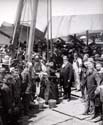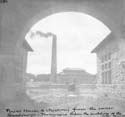|
Gallery | Campus Structures | Quad
On November 11, 1885, Leland and Jane Stanford signed the Grant Founding and Endowing The Leland Stanford Junior University. A memorial to their only child, Leland Stanford Jr., who died of typhoid at the age of 15, the university was established to educate young people to pursue useful careers. Construction of the university began with the laying of the cornerstone in the Inner Quadrangle on May 14, 1887, which would have been Leland Jr.’s nineteenth birthday. Another four years passed before the doors were opened to students on October 1, 1891. Two dormitories, the Inner Quadrangle, and a scattering of other buildings welcomed the more than 500 students and 15 faculty members that first year.
Leland Stanford Sr.’s death in June of 1893 threw the institution into a financial crisis. Because the university had not been incorporated separately from Stanford’s other properties, its assets and income were tied up in probate proceedings. To compound the problem, the federal government filed suit against Leland Stanford’s estate for his presumed share of construction loans originally made to the Central Pacific Railroad. Jane Stanford refused to close the university and funded faculty salaries and university operations with an allocation made to her from the probate judge. By 1898 the financial problems were resolved, and Jane turned her attention to the physical expansion of the campus with a major building campaign.
The physical state of the university in early 1906 was quite different from 1891. The Outer Quadrangle buildings, including major structures at each corner, had been completed. Memorial Church, in its prominent place opposite Memorial Court, was dedicated in January 1903, and the Memorial Arch marked the entrance to the Quad. Far from the relatively unimpressive display that greeted visitors in the early 1890s, Stanford University had become, in just twenty-one years, a commanding presence and seemed poised to become a leader in the advancement of human knowledge. The earthquake of April 18, 1906, would present new challenges and an unexpected opportunity to confirm President Jordan’s assertion that, “it is not buildings that make a university, but professors and students.”
Amidst the devastation on campus was one scene that inevitably brought a smile to faces otherwise downcast--the statue of Louis Agassiz headfirst in the concrete below his perch on the front of the Zoology building. The keystone supporting the statue had given way, allowing Agassiz to dive into the paving below. Even President Jordan, reeling from the destruction of his university, was able to find humor in the marble statue’s abrupt landing. Agassiz suffered a chipped nose, but otherwise was undamaged and soon was reinstalled above the building’s entrance.
Armed with the outside consultants’ report, which estimated the cost of reconstruction at $1,781,384, the Stanford Commission of Engineers began the process of repairing selected buildings ten weeks after the earthquake. Under direction from the Board of Trustees, the commission focused their efforts on the two dormitories, Roble and Encina, and Outer Quad buildings, including the Assembly Hall, Thomas Welton Stanford Library, and Physics corner. Contracts were signed and construction began in early July, barely two months before students were to return. A labor strike in late July threatened further delays, but sufficient repairs were completed to allow the university to reopen for the fall semester.
The Stanford campus would never look the same as it did on April 17, 1906, but the university met the challenge head on and eventually recovered from the devastating quake.
Enrollment for the academic year, 1906-07 was down from the previous year by just over a hundred students.
Student numbers soon returned to pre-earthquake levels, and the university moved forward from that April morning, expanding its academic program, hiring new professors, and educating students as the Founders had wished. Learn more about campus reconstruction on the Walking Tour.
Digital images from the Stanford University Archives represented on this site may be viewed freely. These images may not be reproduced or used for any purpose without permission. For permission requests please contact the Office of the University Archivist
Questions or comments? Email the Web Manager
|







































